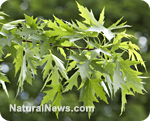
Why You Should Get To Know Neem
Monday, October 27, 2008 by: Katherine East
Tags: neem, health news, Natural News
- Imagine a government SO CORRUPT that it tries to convince the people that ACCOUNTABILITY is ILLEGAL
- Germany and Poland rule out troop deployment to Ukraine
- CIA deploys drones over Mexico to spy on drug cartels, upping stakes in narcotics war
- Social media platforms are beginning to embrace and AMPLIFY calls for violent revolution against Trump
- Two containers with completed ballots fall out of truck in Florida
- Democrats cry as “liberal supply chains” are wiped out and their favorite multi-billion dollar money machine is shut down
- B’nai Brith Canada introduces “Seven-Point Plan to Combat Antisemitism” that proposes suspension, firing or PRISON TIME for violators
- UK’s Online Safety Act comes into effect: The dangerous, slippery slope of censorship laws
- Studies strongly suggest taurine supplementation can promote longevity
- Democrats push to restore government control over online speech: CISA shake-up raises free speech concerns
- Mold often OVERLOOKED as cause of sicknesses, anxiety and depression
- EPA advisor admits the agency is funneling billions to climate groups ahead of Trump’s return to White House
- Stan Johnson on the Health Ranger Report: Henry Gruver’s 2016 vision of second Trump term becomes reality in 2024
- Illinois Gov. Pritzker appoints HIMSELF as co-chair of new group trying to save “democracy”
- CLOT SHOT LOBOTOMY SYNDROME now in full effect for the injected masses as they suffer biological changes to their hypothalamus and frontal lobe
- Mint: The ancient herb that refreshes, soothes and heals
- Britain denies reports that Russia’s “most dangerous” warship held military drills in the English Channel
- U.S. pension systems are on the verge of debt collapse
- Studies strongly suggest taurine supplementation can promote longevity
- Democrats cry as “liberal supply chains” are wiped out and their favorite multi-billion dollar money machine is shut down
- Stan Johnson on the Health Ranger Report: Henry Gruver’s 2016 vision of second Trump term becomes reality in 2024
- Britain denies reports that Russia’s “most dangerous” warship held military drills in the English Channel
- Two containers with completed ballots fall out of truck in Florida
- DIRTY VACCINES: Dr. Anthony "Fraudulent" Fauci, King of the Covid scamdemic, admits "We don't do placebo trials on vaccines"
- U.S. to sell $300 million upgrade program for South Korean navy’s destroyers
- DISNEY executive charged with felony child sex abuse … The empire of Disney has always had a child exploitation secret
- Trump’s reported FBI finalists mark key battle between deep state and loyalist
- Trump’s DOJ to investigate Biden DOJ’s criminal actions against Alex Jones, Infowars
- EPA advisor admits the agency is funneling billions to climate groups ahead of Trump’s return to White House
- UK’s Online Safety Act comes into effect: The dangerous, slippery slope of censorship laws
- This DNC clip shows why Democrats will keep losing...
- Mike Adams and Dane Wigington expose the truth: Are homes being intentionally ignited in California?
- Mold often OVERLOOKED as cause of sicknesses, anxiety and depression
- Illinois Gov. Pritzker appoints HIMSELF as co-chair of new group trying to save “democracy”
- Ukraine’s brutal assassination of Russian General Kirillov reveals the depths of coverup for biological weapons and bio labs in Ukraine
- RFK Jr. clears key hurdle: Sen. Susan Collins backs controversial HHS nominee, signaling a new era for health policy
- EPA advisor admits the agency is funneling billions to climate groups ahead of Trump’s return to White House
- Global leaders unite to clamp down on “misinformation” with UN-backed Cascais Declaration
- HYSSOP: What research reveals about the health benefits of this ancient holy herb
- I Want My Bailout Money – new song released by Mike Adams
- Global tensions, natural disasters and the looming shadow of world war - all predicted by Mike Adams and Steve Quayle three years ago
- The new American dream: $500,000 nuclear bunkers and the fear of WWIII
- Stan Johnson on the Health Ranger Report: Henry Gruver’s 2016 vision of second Trump term becomes reality in 2024
- Top 10 foods that BOOST DOPAMINE and help you stay focused, fit, positive and motivated
- Trump is taking on the media, exposing defamation and WINNING BIG
- Big Banks shift the burden of losses to taxpayers through the Federal Reserve in the form of BAILOUTS
- Is America's "giant debt factory" Federal Reserve setting us up for an economic nightmare?
- U.S. to sell $300 million upgrade program for South Korean navy’s destroyers
- State Farm cancels thousands of home insurance policies in the Pacific Palisades region months before deadly fires
- Biden announces additional $500M military aid for Ukraine as California wildfires displace 70,000 residents
- Experts warn: Centralized digital currencies could be used to control how people behave
- Unearthing Christianity’s hidden history: An amulet’s 1,800-year-long secret unveiled
- Chemotherapy found to increase the number of tumor cells circulating in the blood, spreading it to previously unaffected areas
- Russia signals willingness to negotiate peace deal with Ukraine at neutral site in SLOVAKIA, but Ukraine rejects it
- Red Cross issues warning to stop blood plasma donations from vaccinated people
- Scientists confirm: GENIUS brain function can be spontaneously unleashed in humans without any apparent cause
- DATA: England’s vaccinated population had close to one million deaths in 23 months; unvaccinated population had less than 61,000 deaths over the same period
- HYSSOP: What research reveals about the health benefits of this ancient holy herb
- Arizona residents drive entire Maricopa County Board of Supervisors out of meeting after serving them for TREASON
- Fully vaccinated about to see “tsunami” of illness and death, warns virologist
- Today I asked our AI language model “Neo” about which phytonutrients or phytochemicals can block the spike protein related to SARS-CoV-2 … Here is what it answered…
- Two containers with completed ballots fall out of truck in Florida
- BREAKING: 2025 NDAA authorizes mandatory military draft of WOMEN across America… as Pentagon pursues global NUCLEAR war with both Russia and China at the same time
- We are building the infrastructure of human freedom… Brighteon.AI is the next launch that will put life-altering LLM technology into your hands for free
- Michael Yon warns of a ZIONIST TAKEOVER in Trump’s second administration
- ENGINEERED FAMINE: Oregon starts SHUTTING DOWN small farms “to protect the people”
- NASA admits that climate change occurs because of changes in Earth’s solar orbit, and NOT because of SUVs and fossil fuels
- Ozempic and Wegovy weight loss drugs are injectable LIZARD VENOM PEPTIDES that may unleash a devastating wave of organ failure… side effects align with symptoms of SNAKE BITES
- These 13 countries just signed an agreement to engineer a global FAMINE by destroying food supply
- Careless Whisper: AI-powered transcription tool being used by hospitals found to invent chunks of text no one ever said
- BBC staffers accuse media outlet’s executives of instituting bias in Gaza coverage, claiming favorable treatment of Israel
- BOMBSHELL: DNA testing kits are a SCAM to develop ethnic-specific bioweapons
Traditional Medicinal Uses
The entire tree can be used medicinally to treat a whole lot of ailments - probably why it is affectionately known as "the village pharmacy".
- The young twigs are chewed for keeping gums and teeth healthy.
- The rich and potent margosa oil is obtained from crushing the ripe seeds. This amazing oil has anti-bacterial, anti-fungal, anti-inflammatory, antiseptic and anti-viral properties. It has even been used to treat leprosy.
- The bark and roots can be made into a tea and has been used for centuries to treat jaundice and liver ailments, intestinal parasites, stomach ulcers and malaria.
- A tea made from the leaves and mature seeds is still a popular remedy today for treating bladder, kidney and prostate ailments. This brewed tea can be added to a base cream and used as a healing, soothing treatment forhaemorrhoids.
- A strong tea of the leaves is used as a lotion for sprains, bruises and swollen glands – a bandage or cloth soaked in the hot tea is applied to the area and held in place, often with a banana leaf wrapped around it.
- As a wash and lotion the same tea is used for eczema, rashes, grazes and scrapes and to wash out wounds. Leaves heated in boiling water are applied to boils, sprains, infected wounds, bites, stings and infected grazes.
- Neem leaf tea (pour 1 cup of boiling water over ¼ cup fresh leaves, stand for 5 minutes, strain and sip slowly), is taken to reduce blood sugar levels, lower fevers, and to treat tuberculosis, bladder ailments, arthritis, rheumatism, jaundice, worms, malaria and skin disease.
Neem is also used cosmetically and in toiletries. In India, Neem sprigs are boiled, and the water is then used as a hair wash. Neem hair treatment clears scalp infections and dandruff and stimulates both the growth and texture of the hair and rids the scalp of nits, dry itchy scalp and excessive oiliness. It is very effective in clearing up fungal infections like athletes foot, ringworm and Candida.
Environmentally Safe Natural Insecticide
One of it's most useful properties is its remarkable powers for controlling insects. The leaves are used in libraries and in government and university documents to protect against insect damage. The chemical azadirachitin is the main ingredient for fighting insects and pests and has been found to be up to 90% effective. This chemical is present in the wood, leaves and seeds and works by disrupting the life cycle of the insect as well as repelling them.
Neem is not an instant killer like we've become accustomed to with chemical pesticides. It works differently and more slowly, so some gardeners may question its usefulness. Neem repells insects and acts as an anti-feedant so an insect would rather starve to death than eat a Neem treated plant. If they do eat the plant, the Neem acts as a contraceptive and the insects do not mate or lay eggs so their life-cycle is broken.
Insects must feed on plant tissues to be affected so Neem-treated plants are safe for beneficial insects such as bees and butterflies. Neem oil makes an effective insect repellent for the home. To get rid of mosquitoes, flies and crawling insects from your house, make a strong tea made by boiling the leaves and twigs for 20 minutes in enough water to cover them (alternatively use 1 teaspoon pure neem oil to 1 cup of water), place in a spray bottle and then spray all around.
Use of Neem in agriculture for pest control could significantly reduce the load of poisonous chemicals in the environment. There are many cases of toxication by chemical pesticides which cause serious health hazards to farm workers. Then there's the negative impact from the chemical pesticides seeping into ground water and being absorbed by the crops for human consumption. Neem is biodegradable and breaks down easily and quickly, it is also non-toxic to mammals, birds and earthworms. If you are trying to help stop the destruction to the earth then Neem oil is a good natural pesticide to keep in your garden shed.
References:
Dr. Ram Prakash Srivastava, Neem and Pest Management, International Book distributing Co., 2001
www.neemfoundation.org
Dr. H.S. Puri, Neem the Divine Tree, Harwwod Academic Publishers. 1999
About the author
Katherine Oosthuis is completing a Diploma in Nutritional Therapy. She researches and writes for a health and nutrition website Detox For Life . Her passion is to make research available to those who are looking to improve their well-being and revolutionise their health through better nutrition and alternative medicines.Neem at FETCH.news
Get independent news alerts on natural cures, food lab tests, cannabis medicine, science, robotics, drones, privacy and more.
Take Action: Support Natural News by linking to this article from your website
Permalink to this article:
Embed article link: (copy HTML code below):
Reprinting this article:
Non-commercial use OK, cite NaturalNews.com with clickable link.
Follow Natural News on Facebook, Twitter, Google Plus, and Pinterest
Science News & Studies
Medicine News and Information
Food News & Studies
Health News & Studies
Herbs News & Information
Pollution News & Studies
Cancer News & Studies
Climate News & Studies
Survival News & Information
Gear News & Information
News covering technology, stocks, hackers, and more



"Big Tech and mainstream media are constantly trying to silence the independent voices that dare to bring you the truth about toxic food ingredients, dangerous medications and the failed, fraudulent science of the profit-driven medical establishment.
Email is one of the best ways to make sure you stay informed, without the censorship of the tech giants (Google, Apple, Facebook, Twitter, YouTube, etc.). Stay informed and you'll even likely learn information that may help save your own life."
–The Health Ranger, Mike Adams












































